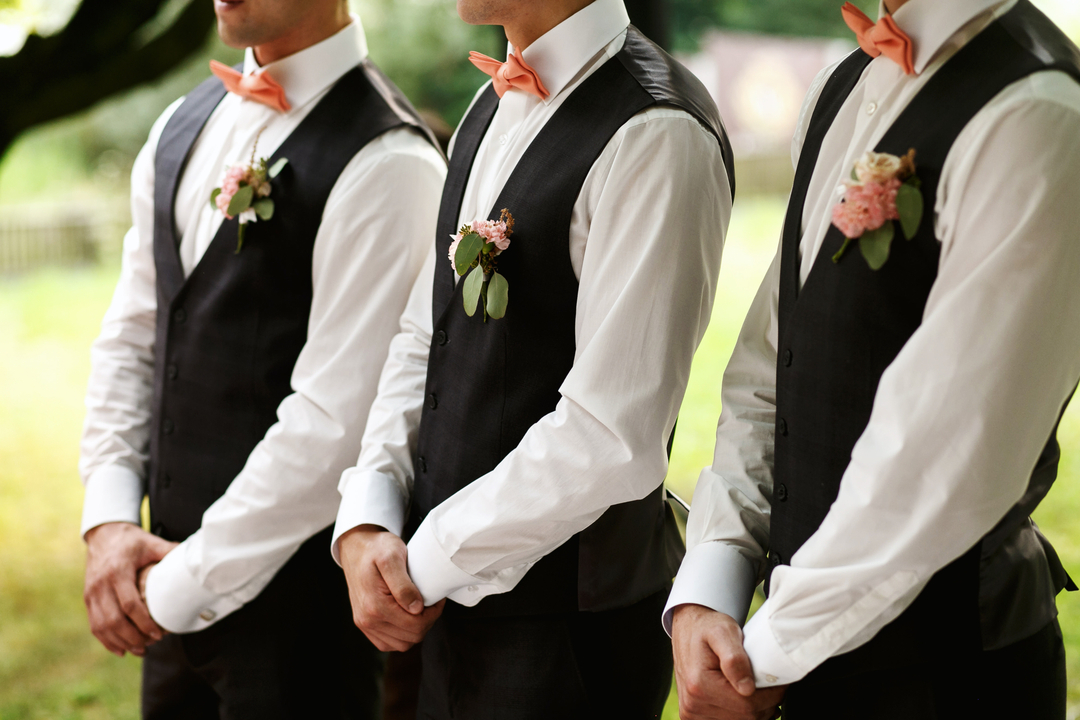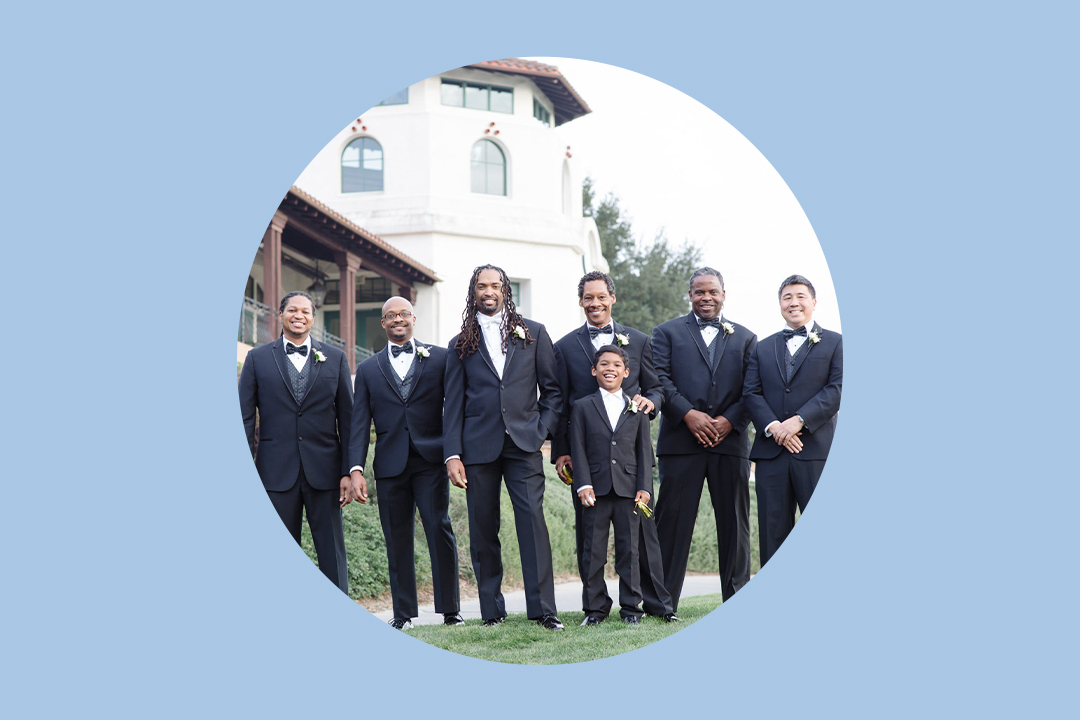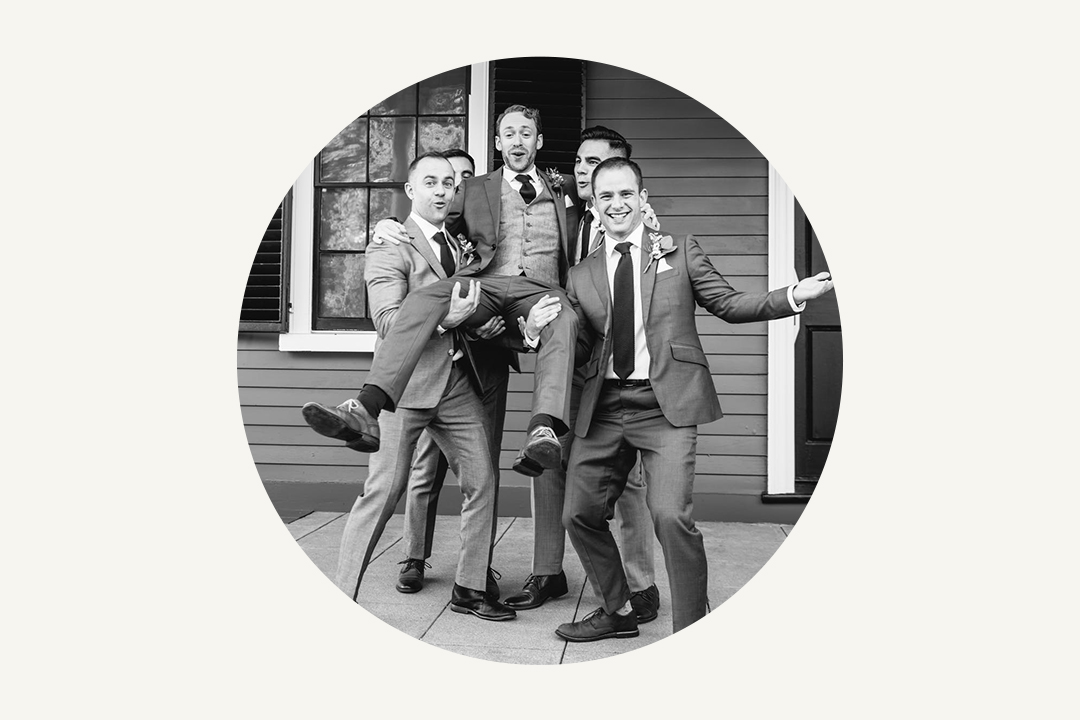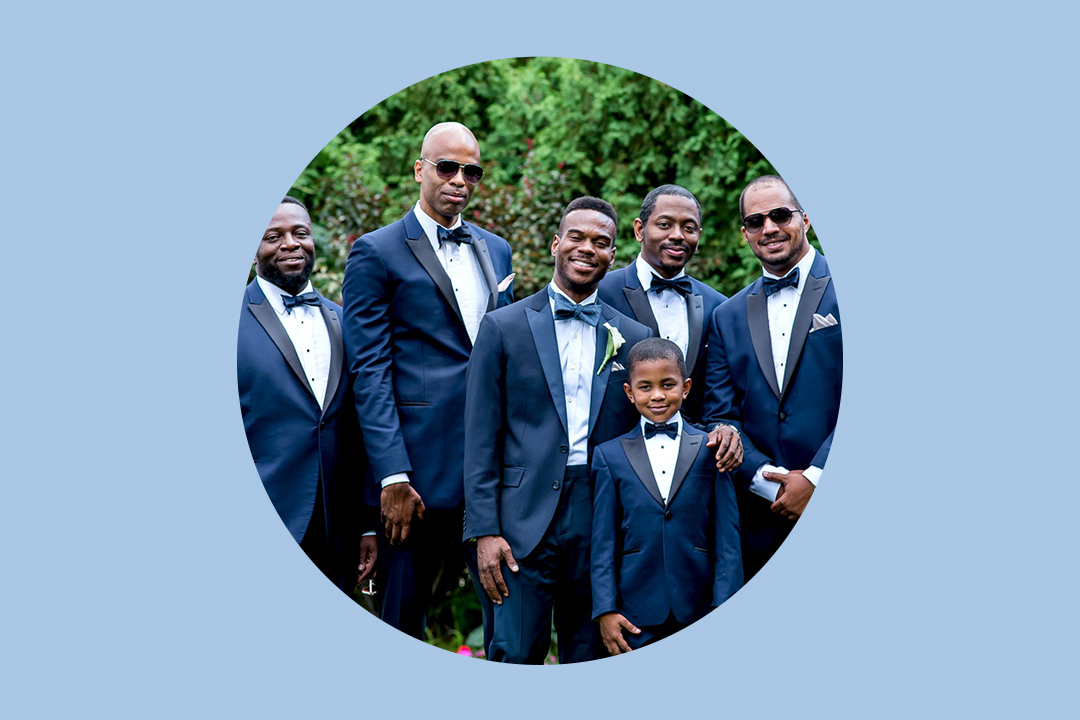- Expert advice/
- Fashion & beauty/
- Wedding attire/
- Groom vs. Groomsmen Attire: What to Wear
- Wedding attire
Groom vs. Groomsmen Attire: What to Wear
The groom and groomsmen typically wear matching attire at a wedding, but there are many options, including: suits, tuxedos, and dress shirts and slacks.
Last updated February 5, 2024

The First Look ✨
- The groom’s and groomsmen’s outfits should match the formality of the wedding and the venue.
- If the groom’s attire matches the groomsmen, it’s important that everyone follows the dress code and goes shopping months in advance.
- If the groom wants to stand out from the groomsmen, styling tricks can distinguish him from members of the wedding party.
Whether you’re the groom or one of the groomsmen, you must look appropriately dapper on the day of the wedding. Eyes will be on you throughout the wedding day and into the evening—and odds are you’ll be featured in many photos. Plus, you’ll want to feel your best. With all of this is mind, we’ve put together a comprehensive groom’s and groomsmen's attire guide.
What's the Difference?
First thing’s first: What are the main differences between groom and groomsmen attire? Because suits and tuxedos can look fairly similar (especially in like colors), a few things a groom can do to stand out from his groomsmen are as follows:
-
Don a boutonniere. Doing so will also ensure that you coordinate with your partner.
-
Wear a different tie or bowtie. This works especially well if your groomsmen’s are all matching.
-
Include a print. Wear a patterned blazer or suit jacket over your dress shirt, or patterned accessories, like socks or your pocket square.
-
Elevate your look. Differentiate yourself by wearing a different color, high quality fabric, or structure and silhouette. For example, if your groomsmen are wearing light gray or black, opt instead for dark gray or navy. Think along the lines of a bridal gown vs a bridesmaid’s dress.
With this in mind, read on for our guide.
Appropriate Groom and Groomsmen Attire
So, what is appropriate groom and groomsmen wedding attire? Here are some things to keep in mind:
-
The groom’s and groomsmen’s outfits should match the formality of the wedding and the venue.
-
Popular groom and groomsmen attire for more formal events include suits and tuxedos, while informal weddings allow for dress shirts and slacks.
-
If the groom’s attire matches the groomsmen, it’s important that everyone follows the dress code and goes shopping months in advance.
-
If the groom wants to stand out from the groomsmen, styling tricks can distinguish him from members of the wedding party.
-
Some grooms want all of their groomsmen to dress individually and not match one another. In these cases, establish a dress code and color palette for everyone to follow.
Groomsmen Attire FAQs
How to Choose Groomsmen Attire
When it comes to selecting and even browsing for groomsmen clothing, there are several factors to be considered. Keeping these top-of-mind can be a tremendous aid in helping you decide on outfit pieces, fabrics, colors, fits, and more.
-
Season. The season the wedding takes place in can have a large influence on what’s worn—especially if it’s an outdoor wedding. Take your cues from the weather and seasonal color palettes for attire that fits seamlessly.
-
Time of Day. Depending on the season and your location, temperatures can vary drastically, from midday to late in the night. Consider what time (or times) of day you’ll be celebrating and dress accordingly. For example, if you’ll be out in the hot sun most of the time, you’ll want to opt for lighter, breezier fabrics.
-
Wedding Venue. You wedding venue dictates much of the feeling and atmosphere of a wedding. Try to match its level of formality when deciding on your attire.
-
Wedding’s Theme or Dress Code. Perhaps most crucial, pay special attention to any information the couple gives you prior to the wedding. Most often, you’ll be notified via invitation or wedding website of the wedding style and dress code. Take note of this when looking for an outfit—and always double check with the couple if you aren’t sure.
What Should the Groom and Groomsmen Wear?
A wedding’s venue and theme should inform what a groom and his groomsmen wear. It’s been said before, but it will be said again: Your outfit’s level of formality should reflect your wedding theme and wedding venue. If you’re getting married in your parents’ backyard, you don’t need to rock a tuxedo (unless that’s your thing). Likewise, nuptials at a place of worship call for a certain style of dress—it’s not appropriate to wear flip flops and a golf shirt in a church.
Who Pays for the Groomsmen Attire?
As with most things involved in wedding planning, this ultimately depends on the couple’s preferences. Most often, each individual groomsmen—as well as other members of the wedding party—will purchase or rent their own attire for the big day. Because of this, they usually also have a say in what they end up wearing. That said, there are cases in which the groom, couple, of even the groom’s parents will offer to chip in to cover some (or all) outfit expenses. This, however, highly depends on their budget and dress expectations.
In any case, communication about who’s going to pay should be communicated ASAP. Read: Before anyone agrees to be a groomsman. It’s crucial that everyone has all of the information they need, such as spending expectations, before committing.
6 Groomsmen Attire Options
Once you determine how formal or informal you can be, decide what you want to wear. Some popular options for grooms and groomsmen include:
Formal Attire
-
Tuxedos. Tuxes are great for formal weddings and black-tie events. They can be worn during all four seasons, and are great for both indoor and outdoor weddings.
-
Dark suits. These days, a nice two- and three-piece dark suit is acceptable for a wedding with a formal dress code. Make sure your suit is well fitted and pressed before the day of.
Semi-Formal Attire
- Suits, either three-piece or two-piece. A three-piece suit can be worn at formal weddings or semi-formal affairs. Two-piece groomsmen suits are a bit more casual and can be dressed down, even more so when the jacket is removed. In any case ,wedding suits should fit well and be pressed.
Casual Attire

-
Vest, dress shirt, and slacks. A play on the two-piece suit, wearing a vest over a dress shirt is a great look for more informal events or summer weddings.
-
Dress shirt and slacks. Paired with a tie or bow tie, this look can be accentuated by suspenders or a nice leather belt.
-
Shirt and khakis. For informal or casual spring/summer weddings, skip the dress pants altogether and sport a pair of chinos with a nice shirt—tie optional.
Matching Groom and Groomsmen Attire
Traditionally, a groom and his groomsmen wear matching tuxedos or suits, but today there are no hard rules. If you want the groom and groomsmen to wear the same attire, whether it be a suit or a dress shirt and pants, consider the following:
-
What is your wedding theme/what are your wedding colors? If you’re having a fall, rustic wedding and are incorporating colors of blush and burgundy, the groom and groomsmen should follow suit. Gray suits with burgundy ties, for example, would be a way to stay on-theme.
-
What are everyone’s budget and location? It’s important to talk about money when you’re at a wedding party to ensure that everyone can afford the same outfit. This can help determine whether you will rent, buy, or borrow garments. Remember that location affects availability and suit fitting appointments if you’re going the custom route.
-
Plan months in advance. If your groom and groomsmen attire matches, go shopping at least four to six months in advance to allow for enough time to order and tailor garments.
-
Another tip? Regardless of whether all groomsmen get fitted for their outfits at the same time and place, or do it individually, it’s a good idea to have everyone’s measurements sent to the tailor two to four months before the wedding—especially during peak wedding season—to ensure that everyone gets their clothing back on time.
A popular style is for groomsmen to match one another, but the groom wears a slightly different, yet complementary, look. If you want the groomsmen to match, but the groom to stand out, consider the following:
- Have the groomsmen’s attire match your wedding theme, but make the groom’s suit or tux slightly different by picking a feature color and highlighting it in different ways. For example, if forest green is one of your wedding colors, have the groomsmen wear green ties and gray suits, while the groom wears a forest green suit and gray tie. This is a way to have everyone look good while standing together, yet still allowing the groom to stand out.
Mismatched Groom and Groomsmen Attire
If matching isn’t your thing, that’s cool. No groom and groomsmen need to dress the same. It’s important, however, that everyone at least looks cohesive and adheres to a dress code. A groomsman wearing linen pants will look odd next to a groomsman in a black tuxedo. The groom should set the tone and let everyone know how formal or casual they can dress and what color palette to stick to.
If you want all groomsmen to sport a navy two-piece suit, communicate what is appropriate. It’s one thing to say, “Everyone wears a blue suit!” but make sure that you also include dress shirts, ties, and shoe styles and colors. If your wedding is more casual and the groom is wearing nice slacks and a dress shirt, the groomsmen should follow. Use terms such as “business casual” and “semi-formal dress” to help the wedding party understand the level of formality that you want them to follow. Use photographs and share ideas with them. It’s a good idea to see (and approve) all groomsmen’s outfits before the wedding to make sure that they a) look good with what the groom is wearing, and b) are within the dress code. This helps to avoid any last-minute fashion disasters.
If the groom and groomsmen's attire doesn’t match, you can incorporate accessories to weave everyone together. Matching socks, ties or boutonnieres are all ways to let the groom and groomsmen stand out from one another, yet still complement each other’s looks.
The type of wedding you’re planning will dictate what the groom and groomsmen should wear. Look to other aspects of your wedding planning, such as venue, season, formality, and whether or not you want the groom and members of his wedding party to match. There’s no right or wrong way to dress for a wedding, but there are ways to ensure that everyone’s attire looks cohesive and fantastic.
Up next for you

Who Pays for the Groomsmen Suits?
Advice
Do the groomsmen pay for their groomsmen suits, or does that financial responsibility fall on the groom?

How to Choose Your Groomsmen
How-To
Read this guide to find out how to determine whom to ask to act as groomsmen in your wedding.

How to Choose Groom and Groomsmen Suits
How-To
You don’t just want to look good on your big day; you want your groomsmen to look sharp, too. Read this guide for how you should go about choosing your and your groomsmen's suits.

A Complete Guide to Groom and Groomsmen Tuxedos + Ideas
Inspiration
Tuxedos are ideal for grooms at formal weddings and black-tie affairs. You can customize your tux with personalized details, such as special cufflinks and playful socks.
- Expert advice/
- Fashion & beauty/
- Wedding attire/
- Groom vs. Groomsmen Attire: What to Wear
Find even more wedding ideas, inspo, tips, and tricks
We’ve got wedding planning advice on everything from save the dates to wedding cakes.
